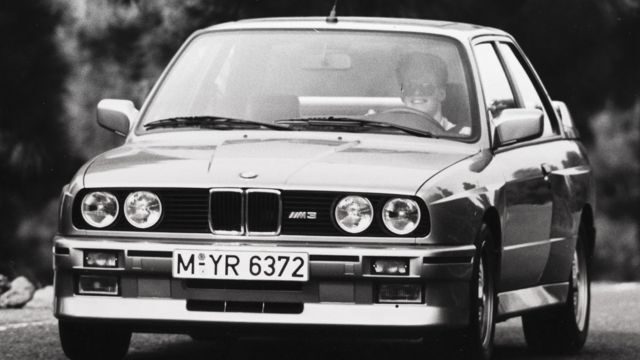‘BACK TO THE FUTURE’ CLASSICS OF THE LAST 30 YEARS
In my series of 12 features entitled ‘Back to the Future Classics’, and appearing on our Western Group’s website throughout 2013, I am looking at a variety of models, differing in character but all held in high regard when launched, and since. I feel that the cars chosen represent “12 of the most significant future classics launched in that time”.
By the mid-1980s BMW had built a formidable reputation in terms of producing attractive, high quality and fast motor cars that were objects of desire as well as mere vehicles built for transportation purposes.
Cars such as the faster versions of the 2002, the 2000C/CS coupés, plus the new, competent 3 Series and 5 Series models of the early 1980s had helped to enhance the brand’s image. BMW was a name commanding respect from buyers, the motoring press and rival motor manufacturers alike.
The E30 3 Series line-up was introduced in 1982, and in the following years these neat, compact vehicles were much appreciated by those who invested in them. The cars were offered in two and four door saloon forms; two door coupé and five door estate (badged ‘Touring’) variants were also built. Buyers could choose between four and six cylinder engines, between them providing a range of power outputs, to suit specific individual requirements.
This was all very laudable, but there was better yet to come. In 1986, BMW launched the sporty M3 version. Rarely imported into the UK officially (it was built only in left hand drive form), the car was of huge interest to enthusiasts in this country (and indeed around the globe), and for good reason.
Under the bonnet of this two door saloon was BMW’s high-revving S14 engine, a four cylinder, twin overhead camshaft 2.3 litre unit, developing approximately 200 bhp at 6,750 rpm, and 177lb.ft. of torque (at a fairly high 4,750 rpm). From the start M3 was available with a catalytic converter allowing 195 bhp output; this gave BMW the basis for an American specification M3 which sold strongly and established a USA market thatoften topped M-branded BMW sales destinations. The considerable power was fed to the rear wheels through a five speed manual gearbox and a limited slip differential.
By contrast with the smart but unadventurous bodywork of the standard 3 Series cars, the M3, although built around the E30’s basic body shell, was externally identifiable by its front airdam (incorporating fog lamps), also colour-matched extensions to the sills and wheel arches, plus a colour-coded rear spoiler, and attractive 15 inch cross-spoke aluminium alloy road wheels.Radical modifications were made to the body outline to improve stability at racing speeds, especially at the rear. Here use of plastic composites allowed a raised profile to the bootlid and the back window was raked to improve airflow to the raised spoiler.
The inside story was told by way of sports seats, plus a leather-trimmed steering wheel and a leather-covered gear lever knob. Standard equipment also included central locking and electrically-controlled door mirrors.
Suspension changes to the all-coil system included the extensive use of aluminium components, plus revised struts and bushes. The brakes were considerably uprated, with special front and rear calipers and discs being adopted from the larger 5 Series.
Late 1989 saw the arrival of a slightly more powerful version (despite its standard-fit catalytic converter), which featured wide (7.5J) 16 inch sports wheels and engine component detailing in BMW Motorsport colours.
Power hikes—which also had relevance in the hardware used for the 300 plus horsepower competition engines – saw showroom power enhanced by Evo-badged stages through 215 to 220 bhp. Finally a 238 bhp, 2 .5 litre, Sport Evo M3 derivative closed production of this legendary model in just 600 individually numbered copies. In total 17,184 first edition M3s were built, including 786 laboriously constructed M3 convertibles.
The M3 (in E30 form) was discontinued at the end of 1990, and although during the years since further variants bearing the same name have been introduced, for many the original version still sets the heart racing in a unique way.
MOTOR SPORT
The initial reason for the existence of the M3 was for use in motor sport by BMW, and the company profitably sold over 500 race cars in kit form to private teams. The model was driven in both motor racing and rallying, winning World and European championship events.
The road car was introduced as a ‘homologation special’, to enable the M3 to compete in Group A Touring Car racing (notably against stiff opposition from the Mercedes-Benz 190E 2.3/16, and Ford’s Sierra RS Cosworth).
DRIVER’S DREAM?
The M3 achieved great success on the track, but, in addition, by comparison with most contemporary sporting saloons, the road versions were in a different league. To start with, the acceleration was spectacularly rapid for a saloon of the 1980s (zero to 60 mph in just seven seconds or so), and the top speed of 140 mph was particularly impressive too.
Even better was the manner in which the car drove, especially on twisting roads, when its near-impeccable handling characteristics shone through. This M3 was always a well-balanced car, enabling faster than usual journey times to be accomplished without drama. For the same reason the model was greatly appreciated in track use, and remains a popular choice today.
Fuel consumption? Typically in the low twenties, per gallon, but in the context of the car’s performance, ‘not bad’!
VERDICT
A true driver’s car of its time. Of course, by comparison with high performance cars of 2013, to most sporting enthusiasts of today it might seem a little lethargic in the power department, and its engine is not the smoothest. All the same, this was the original M3, and a highly revered machine that is appreciating rapidly, in terms of both its reputation and monetary values (especially the later EVO and 2.5 litre Sport versions).
THANKS

For his valued input to this feature, grateful thanks to long-standing and highly knowledgeable classic BMW owner and enthusiast Jeremy Walton, who knew these M3s in their heyday.

